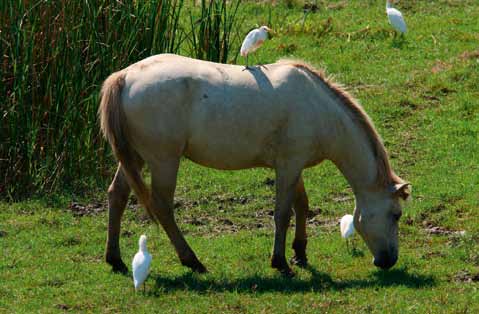
Artikel
Naturschutzgebiete
Isola della Cona
A natural jewel on the northern Adriatic coast
by Károly Erdei
The lagoons of Marano and Grado in the northern Adriatic are of great importance for many breeding and resting birds. There are also several nature reserves located here. The Nature Reserve Isola della Cona is the best area to experience the nature even from close range.
The Lagoons
The lagoons of Marano and Grado stretch from the mouth of the Tagliamento in the west to the mouth of the Isonzo in the east. Several nature reserve were established in the lagoons during the 1990s. These were partly re-designated as former fish lagoons, partly man-made, such as Isola della Cona, which is a secondary habitat. A total ban on hunting has long been in effect in all nature reserves, which has had a very positive effect on the habitat.
Isola della Cona
The Nature Reserve extends along the last 15 km of the Isonzo estuary, about 15 km east of Grado. Particularly important for the nature lover and nature photographer is that part of the nature reserve on the Cona Peninsula, which is predominantly a wetland. The largest part of this area is formed by the lagoons. We can divide the nature reserve into four habitat different units. The first two are the renaturation (ital. "ripristino"), but the most important area for the birds is the protected lagoon with the other two units.
Il Ripristino
The first unit is the renaturation around the visitor center, a wetland of about 20 ha, which can be walked around in about 50 minutes. On the way around the area seven observation huts or observation points are installed, from which one can study the life in the wetland through the observation windows and make photos. The trail is designed in such a way that people do not disturb the birds in the renaturation, in which they are protected by a dam, by dense vegetation or shielded by a wooden wall. Thus, a view of the wetland is possible only from designated sites. This secondary habitat has been designed so that near the observation huts the area is not or only dries out towards the end of the summer. As a result, there are always many waterfowl, especially limicolas to be observed from close proximity and also to be photographed. Here you can easily take good photos of the waterfowl with a 300 mm lens; longer focal lengths like 500 mm are of course an advantage for the small limicolas.
|
|
|
The second unit, a wetland of about 30 ha, was already returned to nature in the early 90s. From an observation house, which covers three levels and was built on the model of a typical fisherman's hut, you can get a good view of the area. For good photos already 400-500 mm and converter are necessary.
To the lagoon area
This area can be hiked around only from the western side. In doing so, one passes through a forest area as the third unit of the nature reserve. Two other observation points help to experience the birds from close by. The fourth unit is a wet meadow with several smaller ponds, which on the one hand are a refuge for amphibians, and on the other hand are the feeding place for limicolas and waterfowl. In late summer, Great White Egrets and Little Egrets flock to these ponds. With some camouflage (camouflage net, mobile camouflage hiding place) you can take very good photos, and of course it always remains a nature experience to watch the birds from close. This area is also grazed by cattle, so after a heavy rain the area can be walked only with rubber boots. From this wetland you can walk along the Isonzo river bank for about 3 km to the tip of the peninsula and from this path you can admire the area of the real lagoon, which is also - especially at low tide - the feeding ground for many birds. This area is more than 1000 ha and cannot be entered, so that the birds breeding or resting here are not disturbed.
|
|
Yellow-legged gull |
The management
A peculiarity of Isola della Cona is the exemplary management of the nature reserve. In order to preserve the special habitat in this unique wetland for many years, the help of four participants has been resorted to: the gray geese graze the short vegetation; they are breeding birds here in a considerable population. The Camargue horses graze further vegetation and live as wild animals in the area. Cattle grazing here from spring to late fall ensure that vegetation inedible to the gray geese and horses is also grazed. The rest is done by humans with tractors and mowers to keep the brush and reeds under control in certain areas. The result of this management, with optimal control of visitors, is a natural area where you can see egrets, limicolas and a wide variety of waterfowl at close range (i.e. a few meters away).
 CamargueHorse
CamargueHorse
|
Greylag Goose |
Nature Pure! My favorite area in Central Europe at any time of the year.
Copyright: Text and all photos: Károly Erdei (http://karoly.erdei.eu)